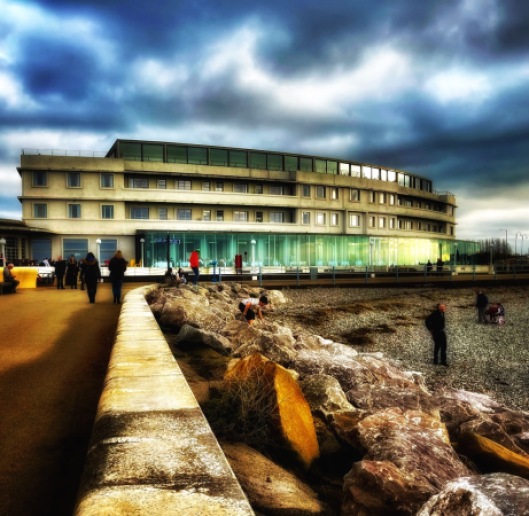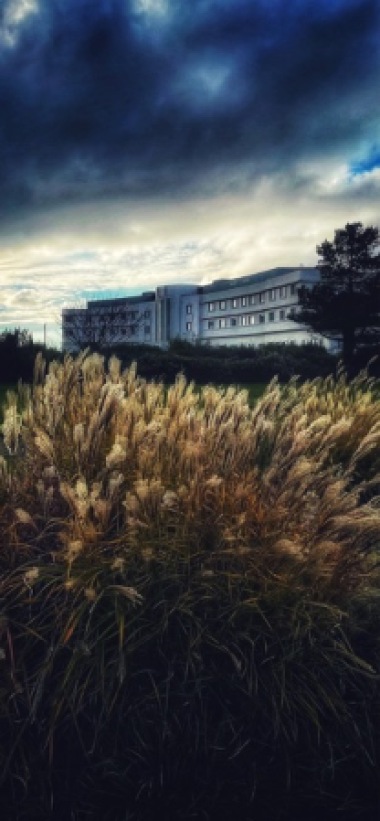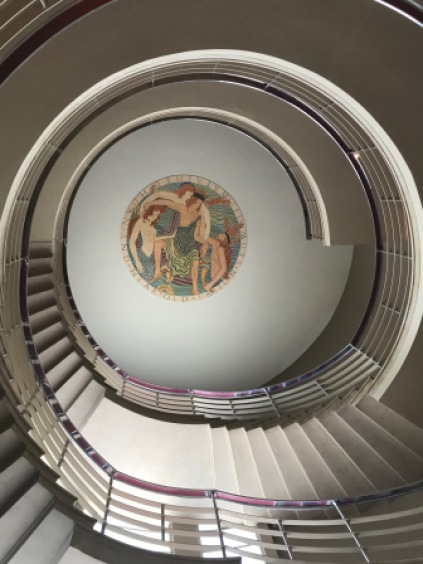
It’s a building I’ve always loved – along with the period from which it came. It looks modern but it was opened in July 1933, at the height of the Art Deco movement in architecture and design. Morecambe, along with most of the classic ‘railway seaside resorts’ has had its fair share of economic challenges since, but the ‘mighty Midland’ remains classy, elegant and, above all, popular.

The hotel was designed by Oliver Hill with interior decoration by Eric Gill. It lies across the main promenade from the station building of the old London, Midland and Scottish Railway, which, at its height, was one of the largest railway companies in Britain.
All the railways hotels owned by the group were named ‘Midland Hotel’. There were also close ties with the nearby ferry port of Heysham, from which ships travelled to Ireland, Scotland and the Isle of Man.

The Midland has always been a favourite of celebrities. These have included Coco Chanel, Sir Lawrence Olivier and Noel Coward. The hotel was the centre of a swathe of Art Deco buildings that made 1930’s Morecambe world famous. Among these were the ‘Super Swimming Stadium’, one of the largest Lidos in the world, with a main dimension of over 400 ft. and the ability to accommodate 1200 bathers and a further 3000 spectators.

Sadly, the rising costs of running this old pool resulted in it being demolished in the 1970s, but there may be good news for the town and the region in the shape of the Eden Project North – a vast marine centre, reflecting the bio-diversity of Morecambe Bay. The plan (below) to build a four-dome marine centre on the site of the old Super Swimming Stadium is in its final planning stages.

The designer of the Art Deco Midland Oliver Hill was a visionary who believed that such buildings, backed by the ‘spirit of the new’ that so typified the 1930s. He realised that the new hotel would give him a chance to put into practice his vision and took personal control of its creation and construction.
Hill observed that “You have here a unique opportunity of building the first really modern hotel in the country.” Hill also took a keen interest in furniture, décor, upholstery and costumes and had gained a reputation for his extravagant interiors, using such materials as glass, chromium, vitrolite, marble and exotic woods.
Hill believed that the exterior design should be intimately linked to the interior decor, and followed the details right down to the colour of the hand towels and the shape of the door handles. He saw these as counterpoints to the austerity of (1930s) modern architecture, providing harmony and balance in an age that was considered quite shocking… and often ‘cold’.

The Midland Hotel is also famous for its sculptures and murals. Oliver Hill commissioned the renowned sculptor and engraver Eric Gill to carve two seahorses for the outside of the building. Inside the building he carved a circular medallion in the ceiling overlooking the staircase. It shows a sea god being attended by mermaids and is edged with the words “And hear old Triton blow his wreathed horn”. Gill also designed an incised relief map of the Lake District and the Lancashire coast for a wall of the South Room, which is today the Eric Gill Suite.

Sadly, the hotel fell into disrepair from the 1970s onwards, like much of the rest of the town. The Midland Hotel was forced to close its doors in 1998, and stood derelict and at the mercy of the sea for nearly ten years.
In 2006 the Manchester-based property developer, Urban Splash, finally began restoring and refurbishing the building. Without Urban Splash this beloved hotel would have been demolished.
The success of what Urban Splash achieve was totemic for Morecambe; and galvanised the old town into seeing that things could change. The council began to redevelop the entire promenade – all three miles of it! Today, Morecambe is talked about as an example of a Victorian resort climbing out of the ashes of its past – whilst retained the best parts of its history.

The Midland re-opened its doors on the 1st June 2008, with beautifully restored existing features, such as the grand cantilevered staircase and a number of artworks by Eric Gill.
It’s easy and reasonably priced to dine at the Midland. The Rotunda bar admits dogs, and the Murder Mystery evenings are really well done, and lots of fun. We took our French relatives for one of these evenings three years ago. The murder theme was based on the TV series ‘Allo, allo.’ The leading actor was playing a Frenchman and came round to our table to introduce himself. I explained that we actually had two French people with us… he stared at me in horror before saying, “Zut, alors, what could possibly go wrong!)
I’ve written quite enough for one blog, but hope to do more on this subject in the future. Time to let the timeless and beautiful lights of the mighty Midland’s front doors say night night…

©Stephen Tanham 2021
Photographs by the author unless otherwise stated.
Stephen Tanham is a Director of the Silent Eye, a journey through the forest of personality to the dawn of Being.
http://www.thesilenteye.co.uk and http://www.suningemini.blog

Fabulous building my wife and I had booked to stay before it was cancelled by Covid but I’m sure we will stay there some time in the future.
I do hope you can, CB! We go for afternoon tea a few times a year. A real treat!
We live in Hertfordshire so it’s a bit of a way but we will definitely get there one year.
Steve, very nice. I love the view of the spiral staircase from the bottom toward the ceiling. Just terrific. Keith
Thank you, Keith. You can tell I’m biased. The spiral often features in period dramas on TV.
Lovely Art Deco. I am completely taken by it – love visiting South Beach in Florida where it is so many street corners! And what a startling concept for the time!
Thanks Noelle. That’s the thing, you just don’t realise how long it’s been there!
Art Deco is one of my favourite architectural styles, right up there with Art Nouveau. 🙂
Me too! Love them both – they were (and are) so ‘fresh’ in their artistic appeal.